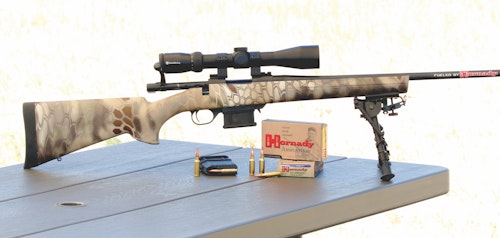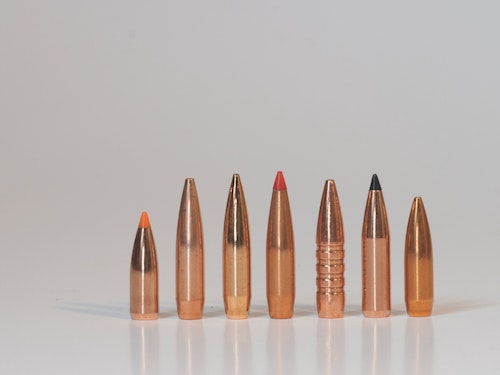Predator rifles are easy to spot. They have camouflaged synthetic stocks with wide, flat-bellied fore-ends holding thick, straight-contour barrels 26-inches long covered in flat-toned or camo Cerakote and screwed to bolt actions. Atop them are 4-20X scopes with 56mm objectives, parallax dials, custom dial turrets and illuminated reticles. They are usually chambered in .223 Rem., .22-250 Rem., 6mm Creedmoor, .243 Win. or .25-06 Rem.
The only exception might be a slim, walnut-and-blued lever action in .22 Hornet or .22-250 Rem. Or maybe a black AR-15 in 6mm ARC. Or a 5-pound ultralight Kimber 84M with 22-inch barrel, 2-7x33 scope, stainless barreled action in 6.5 Creedmoor. Or maybe a …
I think you get my drift. Predator rifles — effective, beloved predator hunting rifles — can be and are whatever a particular hunter wants them to be. If you haven’t found that out yet you’re either new to the game or really set in your ways. Most predator hunters have gone through a long rack of “best” predator rifles. This generally leads to the realization there is no best. There’s only the latest iteration running its course.
Effective predator hunting rifles come in as many flavors as do predator hunters. Big, heavy, small, light, long, short, fancy, plain … And cycled by everything from levers and turn bolts to gas pressure. Heck, there are even successful fur takers who shoot single shots. Very precisely.
During my own 50-year search for the perfect predator rifle, I’ve discovered a system that works for me. Perhaps it might help you define your latest and greatest. Let’s see.

Step One — Know Where You Hunt
Determine what and where you hunt. Bobcats from Carolina swamps call for different tools than coyotes from the windy plains of Wyoming. Will you be encountering most of your targets close or far? In mostly calm air or high winds? Do you need bullets that fly fast and flat or deflect minimally in the wind? Or minimize recoil? Or don’t tear up pelts?
Because I mostly hunt the windy plains for coyotes, with the odd bobcat, red fox and badger slipping in, I like hyper-velocity but also minimum wind deflection. This means a hefty column of powder behind high B.C. bullets without excessive, pelt-tearing energy, thus a narrow caliber, usually .243, .224 and .204. Your needs might be different. Inside 100 yards I’d rather have a .221 Fireball or .22 Hornet than a .220 Swift. Let’s investigate cartridges a bit deeper.
Step Two — Select Your Cartridge
Twenty years ago, we wanted heavy bullets to “buck the wind.” These days we realize we don’t want to buck the wind so much as slip it. Big, heavy bullets aren’t the trick. Long, sleek, fast, high B.C. bullets are. A 245-grain Berger EOL Elite Hunter .308 bullet launched from a .30-378 Whby. Mag. at 2,900 fps truly slips the wind. But its impact on a coyote might be more than a caress or pin prick. Not to mention its impact on your shoulder when you touch it off. Compromise is called for.
Fortunately, we don’t need .30-378 Whby. Mag. performance and massive bullets to minimize wind deflection. All bullets regardless of caliber scribe the same drop and drift trajectory if their B.C. and MV match. This is why new .22-caliber cartridges are being created with fast twist barrels to stabilize 70- to 90-grain bullets! Those are crazy long and that’s why they need 1:8 and even 1:6.5 twist rifling. In .24-caliber, we’re seeing 108- and even 115-grain bullets that require 1:8 to 1:7 twists for stability. But before you go there, truly assess whether the wind deflection savings are worth it. Because to get those heavy bullets to shoot flat, you’ll need fatter or longer (or both) cartridges holding more powder for driving them. A .22-250 Rem. that pushes a 55-grain Ballistic Tip 3,800 fps will be lucky to hit 3,100 fps with an 85-grain bullet. And that means more drop.
Ah, but drop can be accounted for with a solid knowledge of your trajectory and a laser rangefinder for pin-pointing the distance. This inspires many to go for max wind defying bullets instead of flattest trajectory. Especially on the windy plains. There’s a lot of sense in that.
In Eastern forests, Midwest farmland or Southern swamps, neither drop nor drift may be a concern. In those cases, pick whatever mild-shooting cartridge you like with minimal fur damage in mind.
Step Three — Choose Your Rifle
Your cartridge will largely define your rifle. You won’t need a longer, heavier standard action for a 6mm CM, .243 Win., .22-250 Rem. or .223 Rem. But you will need one if you go with a .25-06 Rem. Action style is largely personal choice. Many like the AR platform for fire power. Five, 10, 20 or more shots seem prudent for that oversized pack of coyotes you one day hope to call in. But realistically, how often have you or will you suck in a six-pack of coyotes? And if you do, how many aimed shots can you get off before they disappear? From experience I can tell you it’s at least six, but only one coyote stayed around to count! Better shooters, however, have tallied as many as five and I’m guessing there’s been six, seven or even eight. (Let me know.)
I tried the AR route for a time but came back to the bolt action when I realized it handled and balanced better for me and provided all the firepower and speed I needed 95 percent of the time. I have a buddy, however, who dotes on his Browning lever action in .22-250 Rem. This is one of the few lever guns that has a vertical stack magazine for shooting sharply pointed, efficient bullets. I think Henry is now making one, too.
I will sometimes hunt with a single shot, either a falling block (think Ruger No. 1 and Dakota M10) or a break-action (T/C, Merkel, Blaser K95, H&R Handi-Rifle.) These force me to concentrate and make my shots. And you’d be surprised how often I can get two shots at each calling station. Singles don’t load as quickly as repeaters, but they aren’t molasses in January slow either. Stop fleeing coyote No. 2 with a yiping pup call and you should be ready for your second perfect shot.
Step Four — Sights for Sore Eyes
For most predator hunting, a scope is a sight for sore eyes. Or weak ones. But resist the urge to over-scope. The time I did that (atop a heavy-barreled, wide-stock “varmint” rifle) I ended up with a rig so unwieldy that coyotes literally ran past me, sometimes nearly leaping over the 26-inch barrel, before I could get on them. You probably don’t need 1.4X on a predator rifle, but neither do you require 25X. Unless you’re setting up to snipe at extreme range (beyond 400 yards,) a top end power of 15X, perhaps 18X, will be more than enough. For run-of-the-mill calling setups from Florida to Nevada, I’ve found scopes in the 3-16X range more than adequate.
The small size of some predators (fox, badger) limits maximum point-blank range of targets no bigger than 4 inches (to be on the safe side). My dead-on-hold range with my .22-250 AI spitting a 75-grain bullet at 3,500 fps is 290 yards if I zero 1.75 inches high at 100 yards. Peak trajectory is 2 inches at 150 yards. For shots at 300 to 340 yards, I hold a sliver of daylight over the target’s back. I rarely need to shoot farther than that, most critters approaching much closer to my calling station.
For more precise targeting beyond 300, you might prefer a ballistic reticle with multiple aiming points corresponding to specific distances or MOA drops. Custom dialing turrets might be an even better option, especially if multiple aiming lines or dots confuse you. Whichever system you get, you’ll need a laser rangefinder and plenty of practice time to get proficient. Combine these with steady rests and you should be perfect to 400, possibly 500 yards.

Step Five — Whatever Floats Your Boat
Regardless of what I wrote above, you are free to ignore it all and run with a lever-action .30-30 Win. or your great grandpa’s Colt 45 Auto for your predator work. It’s a free country (more or less) and you have options. Just make sure they make sense for your style of hunting.
These days, after some five decades of sampling a bit of everything, I’ve settled on a middle of the road approach. One favorite is the aforementioned .22-250 AI with a medium-weight 24-inch floating barrel and substantial but not oversized stock. It’s topped with a 4.5-14x40mm Leupold VX3. With a full magazine and sling it weighs 9.5 pounds. I don’t carry it up mountains, but for quick hops from the truck while rolling across the plains, it’s just right. Nestled in my preferred portable shooting sticks, it’s been deadly to 400 yards several times, but does most of its work inside 200 yards.
My other favorite is a slim, trim, 6-pound custom Kimber 84M action chambered in .243 Win. in a laminated walnut stock. The 22-inch barrel is a light sporter. This rig doesn’t maximize long range potential. Its 1:10 twist won’t stabilize the highest B.C. bullets of the day. But it shoots nearly any 100-grain or lighter bullet well under MOA and is a delight to carry. I appreciate the way it leaps to my shoulder and swings with targets. I can call south and spin north to engage a backdoor customer or two in a second. Haven’t knocked off three yet, but one of these days.
Regardless of what manufacturers label their rifles, regardless of when experts and your friends tell you, consider your needs, hunting country and hunting style. And then view all through the lens of your personal likes and dislikes in a rifle. Enjoying your tools is a big part of the joy in predator hunting.







